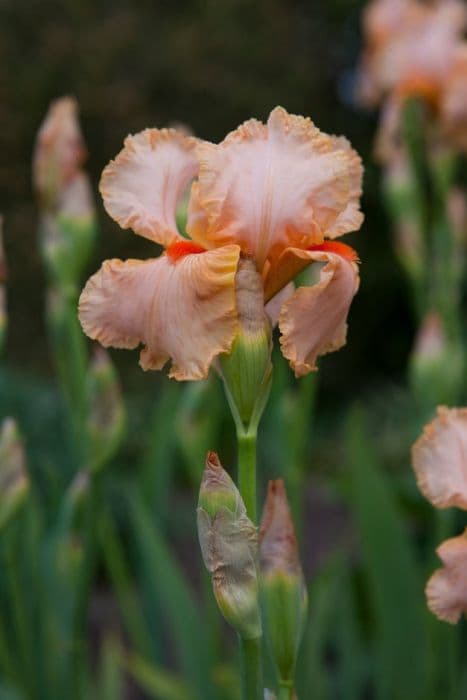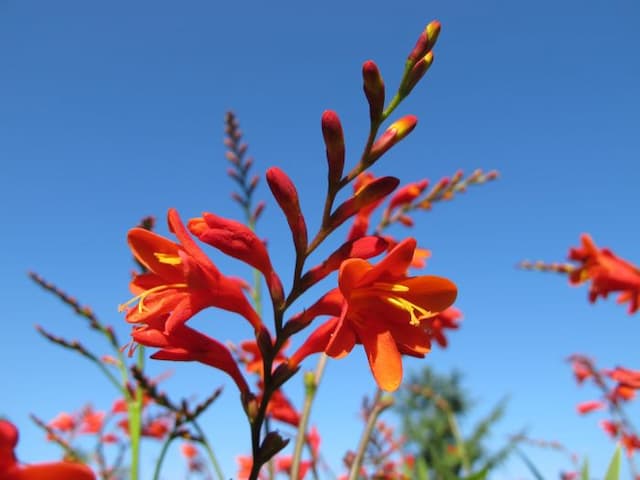Tall Bearded Iris Iris 'Party Dress' (TB)

ABOUT
Iris 'Party Dress' is a strikingly beautiful flowering plant known for its distinctive blooms. The flowers of the 'Party Dress' variety are characterized by their elegant and ruffled petals. These petals exhibit a blend of colors, typically featuring shades of pink, lavender, or mauve, with the standards (upright petals) and falls (downward-arching petals) sometimes displaying contrasting hues or patterns. The standards often stand tall and regal above the falls, which may have intricate veining, speckles, or a wash of color that adds depth and visual interest to the bloom. At the base of the falls, there is often a noticeable beard, a fuzzy line that can be a different color, offering an additional visual highlight. The foliage of Iris 'Party Dress' consists of long, sword-like leaves that are a rich green color, creating a striking backdrop for the magnificent blooms that captivate the attention of any onlooker. This plant typically blooms in the late spring to early summer, presenting a showy display that can add a touch of elegance to any garden. Its sumptuous flowers and lush foliage make it a popular choice among garden enthusiasts who wish to add dramatic flair and ornamental beauty to their landscapes.
About this plant
 Names
NamesFamily
Iridaceae.
Synonyms
Bearded Iris, Tall Bearded Iris, German Iris.
Common names
Iris 'Party Dress' (TB).
 Toxicity
ToxicityTo humans
The Tall Bearded Iris, including the variety 'Party Dress', contains compounds that can be toxic if ingested by humans. These compounds are most concentrated in the rhizomes, the fleshy root-like parts of the plant from which the leaves and flowers grow. If someone eats parts of the iris, particularly the rhizomes, they might experience symptoms such as nausea, vomiting, abdominal pain, diarrhea, and possible dermatitis from skin contact with the sap. Consuming large quantities could result in more serious health issues, though severe poisoning is uncommon.
To pets
The Tall Bearded Iris, including the 'Party Dress' variety, is considered to be toxic to pets if ingested. The rhizomes contain irisin, iridin, or irisine, which can cause gastrointestinal upset in animals such as dogs and cats. Symptoms of iris poisoning in pets may include drooling, vomiting, diarrhea, lethargy, and abdominal pain. As with humans, the greatest risk of poisoning comes from ingesting the rhizomes. If your pet consumes any part of the iris, it is advisable to contact a veterinarian.
 Characteristics
CharacteristicsLife cycle
Perennials
Foliage type
Deciduous
Color of leaves
Green
Flower color
Mixed
Height
2-3 feet (60-90 cm)
Spread
1-2 feet (30-60 cm)
Plant type
Bulb
Hardiness zones
3-9
Native area
Europe
Benefits
 General Benefits
General Benefits- Ornamental Value: Iris 'Party Dress' is highly valued for its large, showy flowers that come in a range of colors, making it a popular choice for ornamental gardens and floral arrangements.
- Drought Tolerance: Once established, it is quite drought tolerant, making it suitable for xeriscaping or gardens with limited water availability.
- Pest Resistance: It demonstrates a natural resistance to many pests, reducing the need for chemical treatments in the garden.
- Easy Propagation: The plant can be easily propagated by dividing the rhizomes, allowing gardeners to expand their collection or share with others.
- Seasonal Interest: Iris 'Party Dress' provides seasonal interest in the garden with its spring to early summer blooms and occasionally a repeat bloom in the fall.
- Attracts Pollinators: The flowers attract bees, butterflies, and other pollinators, contributing to the health of the local ecosystem.
- Low Maintenance: It requires minimal care once established, making it an excellent choice for both novice and experienced gardeners.
- Varied Uses: Suitable for a wide range of garden designs, including borders, water gardens, and as specimen plants.
- Longevity: Iris 'Party Dress' is a perennial, meaning it will return year after year, providing long-term enjoyment with proper care.
- Tolerates Different Soils: This plant can tolerate a range of soil conditions, although it prefers well-drained soils.
 Medical Properties
Medical PropertiesThis plant is not used for medical purposes.
 Air-purifying Qualities
Air-purifying QualitiesThis plant is not specifically known for air purifying qualities.
 Other Uses
Other Uses- Photographic subject: The Iris 'Party Dress' is often used in photography for its vibrant colors and elegant form, making it a popular subject for both professional and amateur photographers aiming to capture the beauty of nature.
- Artistic inspiration: This variety of iris, with its striking coloration, can inspire artists for paintings, drawings, and textile designs, often symbolizing elegance and sophistication in their work.
- Wedding décor: Irises, including the 'Party Dress,' can be used in wedding bouquets and centerpieces to add a splash of color and a touch of natural beauty to the special occasion.
- Educational tool: Horticulture educators may use the Iris 'Party Dress' to teach students about plant hybridization, genetic traits, and the care of perennial plants in a garden setting.
- Culinary decoration: Although not commonly consumed, the petals of the Iris 'Party Dress' can sometimes be used as an organic garnish for high-end culinary presentations due to their attractive appearance.
- Fragrance extraction: The scent of some iris varieties is used in perfumery; the Iris 'Party Dress' may contribute to the complex fragrances in the perfume industry.
- Special events: The Iris 'Party Dress' is often incorporated into floral arrangements for events requiring a touch of sophistication and uniqueness, such as art gallery openings or luxury hotel lobbies.
- Motif in textile design: The elegant form of the Iris 'Party Dress' can be used as a motif in textile design, adding a luxurious and natural element to fabrics.
- Crafting: The dried petals and stems of the iris can be incorporated into various crafts, such as homemade paper or potpourri, to add texture and color.
- Symbolic gift: As the iris is often associated with wisdom and compliments, giving an Iris 'Party Dress' can be a way to convey a message of admiration and respect.
Interesting Facts
 Feng Shui
Feng ShuiThe Iris is not used in Feng Shui practice.
 Zodiac Sign Compitability
Zodiac Sign CompitabilityThe Iris is not used in astrology practice.
 Plant Symbolism
Plant Symbolism- Hope: The iris is often associated with hope, conveying a sense of anticipation for something good in the future.
- Wisdom: In some cultures, the iris represents wisdom, knowledge, and valued friendship.
- Faith: The plant symbolizes faith, embodying belief and trust in something beyond oneself.
- Courage: Irises are also symbols of courage, representing the ability to face challenges with bravery.
- Royalty: Historically, the iris has been connected to royalty and power, especially through its association with the French monarchy's Fleur-de-lis.
- Purity: The flower's elegant appearance has made it a symbol of purity and innocence.
 Water
WaterTall Bearded Irises like 'Party Dress' generally require low to moderate watering. Initially, in the spring, water enough to keep the soil consistently moist as new roots are forming. Once established, watering can be reduced, but during dry spells, provide about an inch of water weekly. Overwatering can cause root rot, so it's important to ensure good drainage. During the growing season, if rainfall is insufficient, water every two to three weeks with approximately half a gallon per plant.
 Light
LightTall Bearded Iris 'Party Dress' performs best in full sun conditions. They require a minimum of six hours of direct sunlight daily to thrive and bloom optimally. The ideal spot would be an area with south-facing exposure that receives unfiltered sunlight for the majority of the day.
 Temperature
TemperatureTall Bearded Iris 'Party Dress' can tolerate a wide range of temperatures but thrives in conditions between 55°F and 75°F. They can survive winter chills down to about -20°F and summer highs up to 100°F with proper care. For peak growth, aim to provide an environment within the ideal range.
 Pruning
PruningPrune Tall Bearded Iris 'Party Dress' to promote health and manage their size. Remove any spent flowers immediately after blooming to prevent seed formation. Pruning back foliage at the end of the season, after a hard frost, helps to minimize overwintering pests and diseases. Every 3-5 years in late summer, divide and trim the rhizomes to rejuvenate the plant and encourage blooming.
 Cleaning
CleaningAs needed
 Soil
SoilTall Bearded Irises, such as 'Party Dress', thrive in well-draining, loamy to sandy soil with a slightly acidic to neutral pH between 6.8 and 7.0. A good mix would be equal parts loamy garden soil, sand, and well-rotted compost for nutrients.
 Repotting
RepottingTall Bearded Irises like 'Party Dress' do not need frequent repotting; they should be divided and replanted every 3 to 4 years to prevent overcrowding and to rejuvenate growth.
 Humidity & Misting
Humidity & MistingTall Bearded Irises, including 'Party Dress', prefer low to moderate humidity levels. They thrive in outdoor environments where the humidity naturally fluctuates but is not consistently high.
 Suitable locations
Suitable locationsIndoor
Provide bright light, moderate temps, and good air flow.
Outdoor
Full sun, well-drained soil, plant rhizomes slightly exposed.
Hardiness zone
3-9 USDA
 Life cycle
Life cycleThe Tall Bearded Iris 'Party Dress' begins its life cycle when the seeds germinate in late summer or fall, requiring a period of cold stratification to break dormancy. After sprouting, the seedlings develop into juvenile plants, forming a small set of sword-shaped leaves at the soil surface. As the iris matures, it forms a rhizome—a horizontal stem from which roots and shoots emerge—and continues to produce larger fans of leaves. The rhizome grows and stores energy, leading to the blooming stage in late spring to early summer, when the iris produces its distinctive large, ruffled flowers. After flowering, the plant enters a period of vegetative growth, where it can be divided and replanted to propagate new plants. Once the growing season ends, the foliage dies back, and the iris enters winter dormancy before beginning its cycle again the following spring.
 Propogation
PropogationPropogation time
Late Summer to Early Fall
Propogation: The most popular method of propagating the Tall Bearded Iris 'Party Dress' is through division, which is ideally done in late summer after the plant has bloomed and begins to go dormant. To propagate by division, gardeners should carefully dig up the clumps of irises and wash or brush off the dirt to better see the individual rhizomes. Healthy rhizomes are typically firm and have at least one fan of leaves and should be cut from the old clump with a clean, sharp knife. The cut ends can be treated with a fungicide to prevent rot. These divisions are then replanted into well-draining soil with the top of the rhizome exposed to the sun, spaced about 12 to 24 inches apart to allow for growth. Once planted, the irises should be watered generously to help establish them, with ongoing care tailored to the plant's needs for moisture and sunlight.








![Montbretia [Little Redhead]](/_next/image?url=https%3A%2F%2Fplants-admin.emdemapps.com%2Fimages%2Fplants%2F%2Fimages%2F604b5635373f8.png&w=640&q=75)
